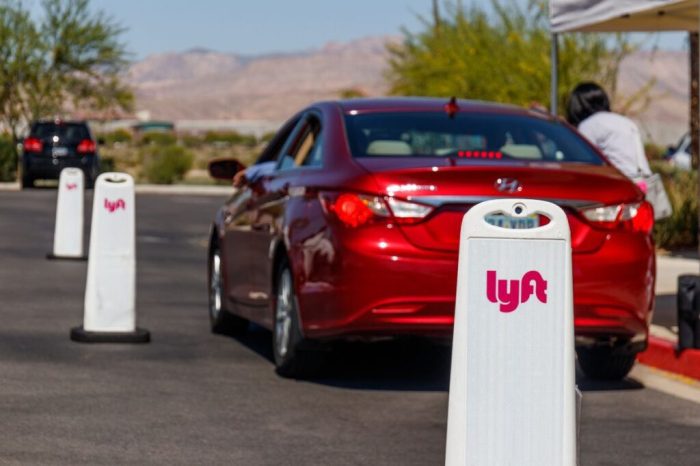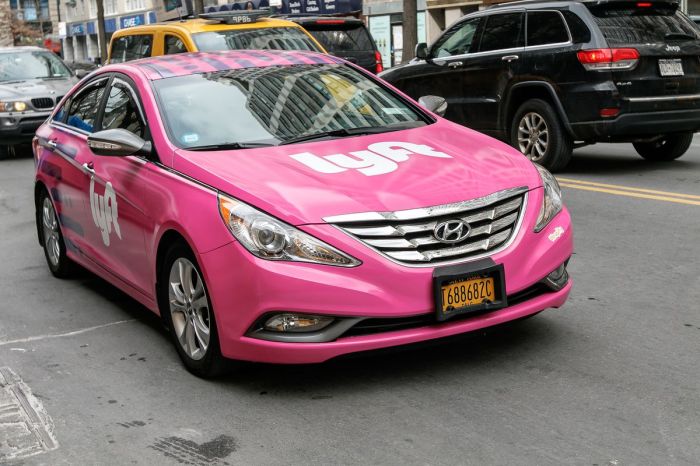Lyft’s Self-Driving Car Program
Lyft, the ride-hailing giant, has become a prominent player in the self-driving car revolution. The company’s journey into autonomous vehicle technology began in 2017, when it established a self-driving car division and started exploring partnerships with leading self-driving companies.
Lyft’s self-driving car program aims to revolutionize transportation by offering safe, efficient, and affordable rides for everyone. The company envisions a future where autonomous vehicles seamlessly integrate into urban environments, reducing traffic congestion, improving road safety, and expanding access to mobility.
Lyft’s Partnerships with Self-Driving Car Companies
Lyft has strategically partnered with several self-driving car companies to accelerate its autonomous vehicle development. These partnerships leverage the expertise and technology of leading players in the field, allowing Lyft to gain valuable insights and resources.
- Aptiv: Lyft collaborated with Aptiv, a global technology company specializing in autonomous driving systems, to launch a pilot program in Las Vegas in 2018. The program aimed to test and refine self-driving technology in a real-world setting, providing valuable data for further development.
- Waymo: In 2018, Lyft and Waymo, Google’s self-driving car subsidiary, announced a partnership to integrate Waymo’s self-driving technology into Lyft’s ride-hailing platform. This collaboration aimed to provide passengers with access to autonomous rides through the Lyft app.
- GM Cruise: Lyft partnered with General Motors’ self-driving car division, Cruise, to develop and deploy self-driving vehicles. The partnership aimed to leverage Cruise’s expertise in autonomous vehicle technology and GM’s manufacturing capabilities to scale self-driving car production.
California’s Regulatory Framework for Self-Driving Cars
California has emerged as a pioneer in regulating autonomous vehicle testing, establishing a comprehensive framework that balances innovation with public safety. The state’s regulatory landscape has played a pivotal role in shaping the development and deployment of self-driving cars, setting precedents for other jurisdictions worldwide.
The Permitting Process for Autonomous Vehicle Testing
The California Department of Motor Vehicles (DMV) oversees the permitting process for companies to test self-driving cars on public roads. To obtain a permit, companies must meet specific requirements, including:
- Submitting a detailed application outlining the testing program, including the vehicles to be tested, the geographic areas, and the testing scenarios.
- Demonstrating that the autonomous vehicle system meets the minimum safety standards set by the DMV.
- Providing evidence of adequate insurance coverage for potential accidents involving the autonomous vehicle.
- Appointing a designated test driver who is responsible for the safe operation of the vehicle during testing.
The DMV reviews each application carefully and may require additional information or testing before issuing a permit. The permitting process ensures that only companies with safe and reliable autonomous vehicle systems are allowed to test on public roads.
Safety Standards and Requirements, Lyft test self driving cars on californias public roads
California’s regulatory framework emphasizes safety as a paramount concern. The DMV has established a set of rigorous safety standards and requirements that autonomous vehicles must meet before they can be tested on public roads. These standards cover various aspects of vehicle performance, including:
- Vehicle Design and Performance: Autonomous vehicles must meet all applicable federal safety standards for passenger vehicles. The DMV also has specific requirements for the design and performance of the autonomous vehicle system, including its ability to perceive its surroundings, make safe decisions, and control the vehicle.
- Driver Oversight: While the autonomous vehicle system is responsible for driving, a human driver must be present in the vehicle at all times during testing. This requirement ensures that a human driver can intervene if the autonomous system encounters a situation it cannot handle. The DMV also has specific requirements for the training and qualifications of the designated test driver.
- Data Collection and Reporting: Companies testing autonomous vehicles are required to collect and report data on the performance of their systems. This data helps the DMV monitor the safety of autonomous vehicles and identify any potential issues. The DMV also requires companies to report any accidents or incidents involving their autonomous vehicles.
California’s safety standards and requirements have been instrumental in ensuring the safe testing of autonomous vehicles on public roads. The DMV continues to update and refine its regulations as the technology advances.
Lyft’s Testing Operations in California
Lyft’s self-driving car testing operations in California are a crucial part of the company’s ambition to revolutionize transportation. Lyft has been actively testing its autonomous vehicles on California’s public roads, gathering valuable data and refining its technology.
Areas of Testing
Lyft’s self-driving car testing in California is focused on various locations, including:
- San Francisco: The company has a significant presence in San Francisco, utilizing its complex urban environment for testing. This includes navigating busy streets, dealing with traffic, and interacting with pedestrians.
- Palo Alto: Lyft’s headquarters in Palo Alto is another primary testing ground. This allows for focused testing in a more controlled environment, with a focus on refining algorithms and software.
- Mountain View: Lyft has been active in Mountain View, a city known for its technology industry and innovation. The city’s diverse road network and pedestrian traffic provide valuable data for testing autonomous vehicles.
Vehicles and Technology
Lyft’s self-driving car fleet in California consists of a variety of vehicles, including:
- Modified Toyota Prius: Lyft’s initial testing involved modified Toyota Prius vehicles. These cars were equipped with a suite of sensors, including cameras, lidar, radar, and GPS, to perceive their surroundings and navigate safely.
- Modified Lexus RX SUVs: Lyft has expanded its fleet to include modified Lexus RX SUVs. These larger vehicles offer more space for sensors and provide a more comfortable ride for passengers.
Lyft’s self-driving technology relies on a combination of:
- Advanced sensors: These sensors include cameras, lidar, radar, and GPS, which work together to provide a comprehensive understanding of the vehicle’s surroundings.
- Artificial intelligence (AI): AI algorithms process the data from sensors to make real-time decisions about steering, acceleration, and braking.
- Machine learning: Lyft’s self-driving technology continuously learns from its experiences, improving its performance over time.
Testing Scenarios and Conditions
Lyft’s testing operations in California involve a wide range of scenarios and conditions, designed to simulate real-world driving situations:
- Urban driving: Lyft’s self-driving cars navigate busy city streets, dealing with traffic, pedestrians, and other vehicles. This helps to refine the technology’s ability to handle complex urban environments.
- Highway driving: Testing on highways allows Lyft to assess the technology’s performance at high speeds, including lane changes, merging, and passing.
- Night driving: Lyft’s self-driving cars are tested at night to evaluate their performance in low-light conditions, ensuring they can accurately detect obstacles and navigate safely.
- Adverse weather conditions: Testing in rain, fog, and snow allows Lyft to assess the technology’s ability to handle challenging weather conditions.
Public Perception and Safety Concerns
The public’s perception of self-driving cars is a complex and evolving landscape, marked by a mix of excitement and apprehension. While many envision a future of safer roads and increased mobility, concerns about safety, ethics, and job displacement remain prevalent.
Public Opinion and Concerns
Public opinion on self-driving cars is a mixed bag. A 2021 survey by the Pew Research Center found that 61% of Americans believe self-driving cars will make roads safer, while 36% believe they will make roads less safe. This reflects a general optimism about the potential benefits of autonomous vehicles, but also acknowledges the anxieties surrounding their implementation.
- Safety Concerns: The most common concern is the potential for accidents caused by malfunctioning autonomous systems. This is a valid worry, as the technology is still in its early stages of development, and there have been incidents involving self-driving cars.
- Ethical Dilemmas: Ethical questions surrounding autonomous vehicles are another major source of concern. For instance, how should a self-driving car react in a situation where it must choose between hitting a pedestrian or swerving into oncoming traffic? Such scenarios raise complex moral questions that require careful consideration.
- Job Displacement: The potential impact of self-driving cars on the job market is another significant concern. Millions of people work in transportation-related fields, and the widespread adoption of autonomous vehicles could lead to significant job losses.
- Privacy and Data Security: Self-driving cars collect vast amounts of data about their surroundings, including location, speed, and even passenger information. This raises concerns about privacy and data security, as there is a potential for this data to be misused or compromised.
Future Prospects for Self-Driving Cars in California: Lyft Test Self Driving Cars On Californias Public Roads
California is poised to become a leading hub for self-driving car technology, with its robust regulatory framework and a thriving tech industry. The state’s commitment to innovation and its focus on sustainability make it an ideal environment for the development and deployment of autonomous vehicles.
Potential Impact on Transportation
The widespread adoption of self-driving cars in California could significantly transform the state’s transportation landscape. Here are some potential impacts:
* Reduced Congestion: Self-driving cars can operate more efficiently than human drivers, leading to smoother traffic flow and reduced congestion on roads.
* Increased Accessibility: Autonomous vehicles can provide transportation options for people who are unable to drive themselves, such as seniors, people with disabilities, and those who live in rural areas.
* Enhanced Safety: Self-driving cars are programmed to follow traffic laws and avoid collisions, potentially leading to a significant reduction in accidents.
* Improved Environmental Sustainability: Self-driving cars can optimize fuel efficiency and reduce emissions, contributing to a cleaner environment.
Economic and Societal Implications
The introduction of self-driving cars will have a profound impact on California’s economy and society.
* Job Creation: The development and deployment of autonomous vehicles will create new jobs in various sectors, including technology, manufacturing, and transportation.
* Economic Growth: Self-driving cars have the potential to boost economic growth by improving efficiency and productivity in various industries.
* Social Changes: The widespread adoption of self-driving cars could lead to changes in urban planning, transportation infrastructure, and social interactions.
* Ethical Considerations: The use of self-driving cars raises ethical questions about liability, privacy, and the potential for job displacement.
Future Regulatory Landscape
California’s regulatory framework for self-driving cars is evolving as the technology continues to develop.
* Continued Testing and Development: The state will continue to support testing and development of self-driving car technology, while ensuring safety and public confidence.
* Data Privacy and Security: Regulations will likely address data privacy and security concerns related to the collection and use of data by self-driving cars.
* Liability and Insurance: The state will need to establish clear guidelines regarding liability and insurance for accidents involving self-driving cars.
* Integration with Existing Infrastructure: Regulations will need to address the integration of self-driving cars with existing transportation infrastructure, such as roads, traffic signals, and public transportation systems.
Lyft test self driving cars on californias public roads – The journey of self-driving cars on California roads is just beginning. Lyft’s ambitious foray into this cutting-edge technology has sparked a conversation about the future of transportation, raising questions about safety, regulation, and societal implications. As the technology continues to evolve, we can expect to see further developments, partnerships, and challenges in the years to come. The road ahead for autonomous vehicles is paved with both opportunities and uncertainties, and Lyft’s role in this evolving landscape is sure to be watched closely.
While Lyft is busy testing its self-driving cars on California’s public roads, a different kind of innovation is about to take the world by storm: moto maker to gain worldwide availability this march. This platform will revolutionize how we design and create custom motorcycles, making it easier than ever to build your dream ride. Imagine the possibilities! Maybe someday, we’ll see self-driving motorcycles cruising down the California highways, powered by the creativity of moto maker.
 Standi Techno News
Standi Techno News

